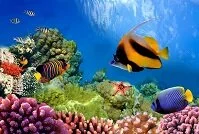Winters in Australia (June to August) experience colder temperatures nearly everywhere. The temperatures in the north don't get too much lower during the days (although at nights they can dip to 66° F (19° C)), but the humidity seems to take a break and the rains ease back from about April to September. Sydney, Perth, and many other cities in the south are usually in the mid-40s° F (6-8° C) at night, but temperatures still get into the low-60s° F (16-18° C) most days. Not unlike the summers, the interior has very cold nights (30-40s° F (2-9° C)) and day time temperatures also drop, although it tends to stay in the 60s or 70s° F (18-26° C) most days.
The in between seasons vary between the summer and winter extremes, but are less predictable as rain and temperature swings can be significant and rapid. The exception to this is again in the north where these moths tend to shift from rainy to dry or vice versa.
Wildlife

Great Barrier Reef
Australia has one of the most unique ecological systems in the world as the country is home to hundreds of bird, mammalian, fish, and reptilian species, many of which are native to Australia and can be found nowhere else on earth. For this reason many animals found elsewhere in the world are absent in Australia and many animals in Australia can only be found here... and in foreign zoos.
The mammal life in Australia is filled with many unique animals now known throughout the world as the country is home to kangaroos, koalas, dingoes, wombats, wallabies, Tasmanian Devils, and platypuses among other unique animals. More common mammals can also be found, such as bats and small rodents. Other common animals also arrived with people, particularly settlers from New Guinea, who brought with them pigs, dogs, mice, and rats among others.
The waters surrounding Australia are also home to mammals in the form of dolphins, whales, and sea lions. More than the mammals in the waters around Australia, the fish and other sea life is incredibly diverse. The amount and variety of coral reefs off the country's northeast coast (the Great Barrier Reef) is the world's largest and most diverse coral system in the world. The reefs also attract thousands of animals from fungi and starfish to mackerel and sharks. Among the many animals around the corals, as well as off the other coasts, are surgeonfish, clownfish, sailfish, puffer fish, butterfly fish, grouper, barracuda, tuna, mackerel, marlin, mahi-mahi, shrimp, krill, crab, oysters, seahorses, manta rays, sharks, jellyfish, starfish, and sea urchins among many others. The country's inland lakes and rivers are also home to many freshwater animals including perch, spiny lobster (or crayfish), and bull sharks have been known to swim upstream as well.
The water and the land have attracted more than just fish, they have also attracted numerous birds, including many that feed off the animals in the sea. The bird life in Australia again includes both common species as well as some more unique to Australia, including doves, owls, honeyeaters, emus, swans, lyrebirds, cockatoos, parakeets, budgerigars, passerines, scrub fowls, heron, and in the far south even some species of penguin. Early settlers also introduced the chicken, perhaps settlers who arrived from New Guinea or another island to Australia's north.
Like the mammalian life, the reptilian and amphibious life is fairly distinct and diverse. The most well-known and feared of these animals are snakes as dozens of species exist, including most of the world's most poisonous. Lizards, toads, frogs, and turtles are also common on land and in the waters around the country.
The insect and other small animal life is fairly diverse. These animals include butterflies, bees, ants, flies, snails, spiders, and worms among others.
Like the animal life, the plant life is also quite diverse. Many plant species in Australia have existed in the country for thousands of years and the island is home to many of the oldest plant species in the world. Among these plants are included acacia trees, eucalyptus trees, palm trees, mangrove trees, fungi, ferns, mosses, daisies, hibiscus, frangipani, and thousands of additional tree, flower, and plant species. In addition to these plants, many others have arrived thousands of years ago from the nearby islands to Australia's north including coconuts, taro, breadfruit, bananas, yams, arrowroot, lemons, and sugarcane among others.